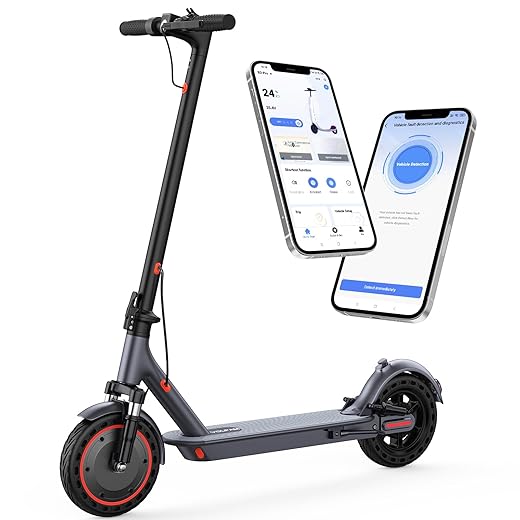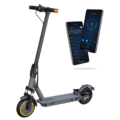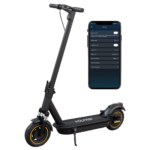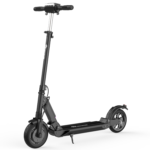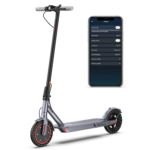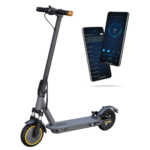- Home
- Scooters
- Electric Scooters
- VOLPAM SP08
VOLPAM SP08
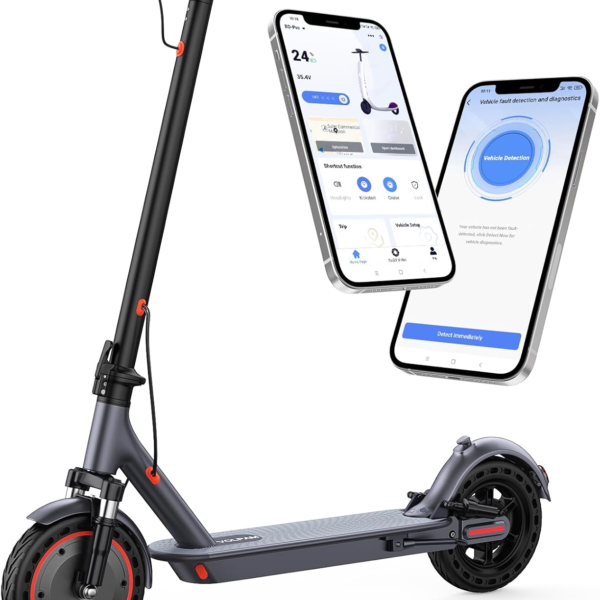

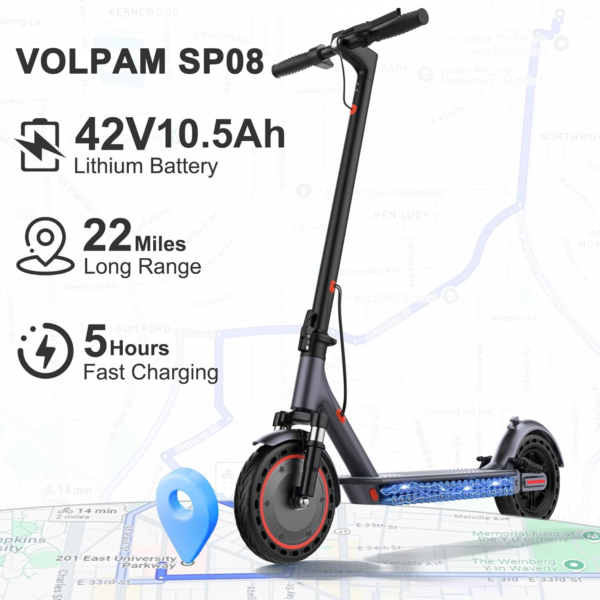
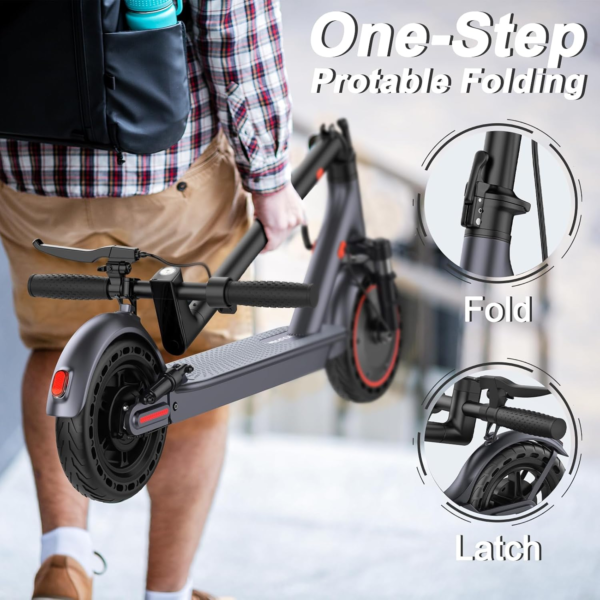
- Battery Range: 23 miles (37 km)
- Top Speed: 22 mph (35 km/h)
- Motor Power: 500 W
- Weight Capacity: 264 lb (120 kg)
- Charging Time: Approx. 4–5 hours
- Scooter Weight: 29.5 lb (13.4 kg)
PROS
- 500W hub motor with strong acceleration
- 10″ solid honeycomb tires
- Dual suspension for comfort
- Dual braking: E-ABS front + rear drum
- App support and cruise control
- Max rider weight 264 lb
CONS
- Solid tires reduce plushness versus pneumatics
- Battery capacity not widely published on official page
- Limited hill-climb on steeper grades
- Folded/unfolded dimensions not specified
Table of contents
- What Is the VOLPAM SP08?
- How the VOLPAM SP08 Works
- Key Specifications
- Design & Build Quality
- Performance Fundamentals
- Battery, Range & Efficiency
- Ride Quality & Comfort
- Braking & Safety Features
- Portability & Daily Usability
- Maintenance & Care
- Weather & Seasonal Considerations
- VOLPAM SP08 vs Alternatives
- Who the VOLPAM SP08 Is (and Isn’t) For
- FAQs
- Glossary
- Final Notes for Owners
Key Takeaways
- The VOLPAM SP08 is a compact e-scooter with a 500W motor, suitable for city commuting and short trips.
- It features dual suspension, 10-inch solid honeycomb tires, and a top speed of 22 mph (35 km/h).
- Riders enjoy a rated range of up to 22 miles (35 km) and a simple one-step folding mechanism for easy transport.
- Key specifications include a weight limit of 264 lb (120 kg) and a charging time of 4–5 hours.
- Ideal for urban riders, students, and those preferring low maintenance, but not for heavy riders or those needing all-terrain capability.
The VOLPAM SP08 is a compact, foldable e-scooter built for daily city life. It carries a 500W hub motor, dual suspension, and 10-inch solid honeycomb tires. It suits short commutes, campus runs, and quick errand loops. And if you want simple controls with low fuss, it fits. If you want a same-brand point of reference before you decide, take a quick look at the VOLPAM Q1 for comparison.
So this guide walks through how it works, what it does well, and where it falls short. You’ll get plain facts, quick tips, and a feel for real use. Then you can decide if it matches your routine.
What Is the VOLPAM SP08?
The SP08 is a commuter scooter for adults. It runs a brushless 500W motor, a 42V battery, and a one-step folding latch. The deck supports riders up to 264 lb (120 kg). And the 10-inch solid honeycomb tires laugh off punctures, so flats drop from the worry list.
Even so, it stays friendly for first-time riders. You get electronic braking with light regen and a rear drum brake. You get dual suspension for cracked pavement and a clean cockpit with a small display. The companion app adds lock, light control, cruise, and a speed cap. Top speed lands near 22 mph (35 km/h). Rated range reaches up to 22 miles (35 km) on flat paths with calm weather. And its specifications place it in the light-commuter class.
How the VOLPAM SP08 Works
A scooter is a short list of parts that need to play nice. So here’s the quick tour.
Motor and controller. A 500W brushless hub motor sits in one wheel. The controller feeds it current based on throttle and mode. Power comes on in a smooth ramp, so launches feel steady. Peak draw hits during starts and short climbs. Then it eases once you cruise.
Battery. The pack is 42V, 10.5Ah, about 441Wh. Cells sit inside the frame, and a basic BMS watches charge, discharge, and heat. Plug in the stock charger and expect a full charge in roughly 4–5 hours. Then unplug and ride.
Throttle. A right-hand thumb lever talks to the controller. Several ride modes change the speed cap. And cruise control holds a pace after a brief steady input, so long straightaways feel easier.
Brakes. Up front you get E-ABS with regenerative braking. In back you get a mechanical drum brake. Use both together for the quickest, cleanest stops. Lever feel stays firm, and the scooter tracks straight.
Lights and display. A headlight, a tail light, and reflectors cover the basics. The center display shows speed, battery bars, and mode. Then the app mirrors key info and adds quick toggles.
Key Specifications
General
| Item | Detail |
|---|---|
| Model | VOLPAM SP08 |
| Rider weight limit | 264 lb (120 kg) |
| Recommended rider age | 16+ |
| Frame material | Aluminum alloy |
| Colors | Black/Gray |
Performance & Power
| Item | Detail |
|---|---|
| Motor | 500W brushless hub motor |
| Top speed | ~22 mph (35 km/h) |
| Hill capability | ~7–10% grades on short rises |
| Drive | Hub motor (wheel placement not stated) |
Battery, Charging & Electrical
| Item | Detail |
|---|---|
| Battery | 42V 10.5Ah, ~441Wh |
| Charging time | ~4–5 hours |
| Rated range | Up to 22 miles (35 km) |
| BMS | Yes (battery protection) |
| App | Lock, lights, cruise, speed cap, modes |
Build & Dimensions
| Item | Detail |
|---|---|
| Tires | 10-inch solid honeycomb |
| Suspension | Dual shocks: front and rear |
| Product weight | ~29.5 lb (13.4 kg) |
| Unfolded dimensions | Not published |
| Folded dimensions | Not published |
| Package size | 46.46 × 22.83 × 6.89 in |
Safety & Control
| Item | Detail |
|---|---|
| Brakes | Front E-ABS + rear drum |
| Lights | Headlight, tail light, reflectors |
| IP rating | Not specified (avoid heavy rain) |
| Bell/Kickstand | Included |
Features & Extras
| Item | Detail |
|---|---|
| Cruise Control | Yes (app/display toggle) |
| Ride modes | Multiple speed caps |
| Display | Speed, battery, mode |
| Folding | One-step latch, stem carry |
Warranty & Compliance
| Item | Detail |
|---|---|
| Warranty | 12-month or 180-day by part group |
| Electrical safety | UL 2272 claims may vary |
So that covers the headline specifications. Next, let’s turn the sheet into ride feel.
Design & Build Quality
The layout is simple and tidy. The stem is straight, with a centered display and a right-hand thumb throttle. The brake lever sits on the left. Cables run close to the stem, and nothing sticks out to catch a sleeve. Then the folding latch sits low, which keeps the deck clear for your feet.
The deck gives enough room for a staggered stance. Grip feels sure under sneakers, and the edges stay out of the way. Put your front foot slightly angled and your back heel near the fender. That stance helps when you need a quick weight shift under braking. It also calms the scooter on rough patches.
Fit and finish are solid for the class. Plastics around the light and display feel snug. Fasteners sit low and stay out of sight. Paint holds up to daily scuffs. And the stem clamp snaps shut with a clean bite, so unfolding turns into a quick, repeatable motion.
Dual suspension is the big upgrade. Small shocks in front and rear shave off buzz from chip seal and shallow cracks. They won’t erase big potholes. Still, they take the sting out of city streets. The 10-inch honeycomb tires flex a touch too, so the ride doesn’t feel harsh like old solid tires did.
Performance Fundamentals
Starts feel smooth. The controller gives the motor a short ramp, so there’s no head-jerk. Kick once, press the throttle, and it climbs to pace in a clean line. In stop-and-go blocks, that pattern feels calm and easy.
Cruising at 15–18 mph (24–29 km/h) is the sweet spot. The scooter tracks straight and stays stable through light steering inputs. Deck height gives your legs leverage for turns without tagging curbs. Then, as speed climbs, wind and road noise rise. So leave more space and keep your hands relaxed.
Hill work depends on grade and rider weight. On 7–10% slopes, it keeps a steady crawl when the battery is fresh. Short ramps over bridges are fine. Long grades will pull speed down, and hot days make that drop show up sooner. So charge before big hills and pick a slower mode when you need it.
Battery, Range & Efficiency
Capacity sits around 441Wh. That covers most city trips in one charge. The rated figure tops out near 22 miles (35 km). Treat that as best-case: flat paths, mild temps, a moderate rider, and light wind.
Real range moves with speed, stops, hills, and cold air. Tire losses count too. Speed matters most. Ride around 15 mph (24 km/h), and you stretch distance. Sprint and brake a lot, and range shrinks fast. So choose a mode that matches your plan, and you’ll get more miles without trying harder.
Charging takes roughly 4–5 hours from low. The brick is small enough for a backpack, so you can top up at work. Partial charges are fine for short hops. The BMS keeps guard on the cells, yet steady habits still help. Don’t leave the pack empty. Don’t bake it in a car. And keep the charge port covered and clean.
Simple charging habits
- Plug in after rides that end near half.
- Unplug soon after full.
- Park somewhere cool and dry.
- Wipe the port cover before you charge.
- If you pause for weeks, store around half charge.
Ride Quality & Comfort
Solid tires win on upkeep. The honeycomb pattern adds a little give across the tread. That mix softens chatter and shrugs off glass and nails. On gravel, steering feel gets a bit vague. On wet paint, slow down and hold a steady line.
The small shocks soak up expansion joints and shallow cracks. Then the tire carcass eats the finer buzz. Deck height leaves your knees room to work as the final spring. Stem flex stays low at city speeds, and the bar never whips around on sharp hits.
Bar width is modest. Shoulders stay relaxed in traffic. The thumb throttle has a short throw with a crisp return. Brake reach feels natural for most hands, and bite builds in a smooth arc. Plus, the bell sits close for quick cues when paths get crowded.
Braking & Safety Features
Two systems share the work. The front E-ABS uses the motor to slow you down. Roll off the throttle and you feel a light drag; squeeze the lever and it pulls harder. A bit of that energy slips back into the battery. Then the rear drum adds mechanical bite you can count on every time. Lever feel stays linear, and the scooter holds a straight line under hard stops.
Lights cover the basics. The headlight handles near-field, and the tail light makes you noticeable in traffic. For night rides, add a helmet light if you want more reach. Side reflectors help at angles, so add them if your unit shows up without them.
There’s no listed ingress rating. So avoid heavy rain and standing water. Light spray happens in cities, yet deep puddles can reach bearings and connectors. If you roll through wet streets, dry the scooter, check brake feel, and let it return to room temp before charging.
Portability & Daily Usability
At about 29.5 lb (13.4 kg), the SP08 is carryable for one flight of stairs. Two flights are doable with a short pause. The one-step latch speeds the fold. Flip the catch, lower the stem, hook it, and go. After a few days, it turns into muscle memory.
The folded shape slips into trunks and under desks. Train and bus doors are fine when you hold the stem near the clamp and point the rear wheel forward. At home, hang it on a wall hook or park it along a closet. And try not to leave it baking in a car, since heat ages batteries fast.
For locks, pick a compact U-lock or a chunky chain. Thread a wheel triangle or a frame gap. Don’t lock only the stem. Park in sight when you can. A little alarm puck inside the deck adds a loud surprise that scares off quick grabs.
Maintenance & Care
Short, regular checks keep scooters feeling tight. The SP08 keeps the list small, so it’s easy to stick with.
Every ride
- Squeeze the brake and feel for firm bite.
- Roll a few feet and confirm motor pull.
- Check the latch after you unfold.
- Scan the tire tread and tap the bell and lights.
Weekly
- Spin both wheels and listen for rubs.
- Wipe grit from the deck, stem, and joints.
- Snug any visible stem and bar fasteners.
- Open the app and look at battery logs for odd drops.
Monthly
- Check drum-brake cable tension and adjust.
- Clean the brake arm and housing.
- Inspect the charge port cover.
- Check the folding latch for play, then tighten if needed.
Seasonal
- Deep-clean the frame and wheels.
- Look for cable kinks or frays.
- Treat light screw rust with a drop of oil.
- If you’ll store it a while, leave the pack around half.
Solid tires delete tube care from your life. Even so, peek into the honeycomb holes and flick out debris. Then ride feel and noise stay consistent.
Weather & Seasonal Considerations
Heat and cold affect range and brake feel. In summer, charge to full right before long rides and park in the shade. In winter, keep the scooter indoors before you head out. Then ease into the ride so the pack warms up. Painted lines and metal plates stay slick long after the asphalt dries, so give them extra space.
Rain raises risk fast. The maker warns against heavy rain, and that’s smart. So treat wet days as off days when you can. If you must ride, slow down, leave more room, and brake early with light pressure. Then dry the scooter, let it warm back up, and charge after.
Sun ages plastics and grip tape over time. So park in the shade during long stops. A simple cover at home keeps dust out of the latch and joints and helps the fold keep snapping shut.
VOLPAM SP08 vs Alternatives
Commuter scooters fall into clear buckets. The SP08 sits in the light-commuter bucket with an eye on comfort and low upkeep. So here’s how it stacks up.
- Versus basic commuters with 8.5-inch solid tires
The SP08 rides smoother over broken asphalt. The 10-inch honeycomb tires and dual shocks help on rough lanes. Daily comfort goes up without adding tube work. - Versus mid-weight commuters with pneumatic tires
Air tires ride softer and grip better in rain. They can puncture, and flats take time. The SP08 trades a bit of wet grip for zero flats and lower care. Owners who value easy living may prefer that. - Versus performance scooters
Bigger motors and packs bring speed and hill punch. They also bring weight. The SP08 aims for balance. It’s quick enough for city blocks, light enough for stairs, and easier to store. - Versus off-road scooters
Knobby tires and long travel love dirt. The SP08 doesn’t. It sticks to pavement and packed paths, which keeps weight and price in check.
So the SP08 shines when you want grab-and-go utility, steady comfort, and almost no maintenance. And if you prefer to stay within the same lineup while you compare, the VOLPAM SP01 is another option worth a look.
Who the VOLPAM SP08 Is (and Isn’t) For
Great fit
- City riders with trips under 8–12 miles (13–19 km) each way
- Students and staff hopping between buildings
- Multi-modal riders who mix in train or bus segments
- Owners who want solid tires and no flat repairs
- New riders who like calm throttle and simple controls
Not a fit
- Heavy riders facing long 12–15% grades every day
- Trail users who need knobby tires and long travel
- Speed chasers looking for 30+ mph (48+ km/h) runs
- Rain-or-shine riders who expect a listed IP rating
FAQs
How fast is the VOLPAM SP08?
Top speed lands near 22 mph (35 km/h). Wind, rider weight, and slope can nudge that number.
What is the real-world range?
It varies with speed, stops, terrain, weather, and rider weight. The rated figure is up to 22 miles (35 km). Many mixed routes land lower, which is normal.
Does the SP08 have cruise control?
Yes. Toggle it on the display or in the app. Hold a steady speed for a moment, and it locks in.
Is the VOLPAM SP08 water-resistant?
There’s no posted IP rating. Avoid heavy rain and standing water. Plan around weather when you can.
How much does the scooter weigh?
About 29.5 lb (13.4 kg). Hardware and add-ons can move that number a bit.
What kind of tires does it use?
10-inch solid honeycomb tires. They resist punctures and ride better than old solid types. Slow down on wet paint and metal plates.
Where can I find a quick VOLPAM SP08 overview?
Right here. This VOLPAM SP08 overview covers motor, battery, brakes, comfort, care, and fit so you can compare it with similar scooters.
Glossary
Ah (amp-hours). Battery charge capacity; higher Ah means more stored charge.
Wh (watt-hours). Voltage times amp-hours; it shows stored energy.
Controller. The box that meters current to the motor from your throttle.
BMS. The system that protects cells during charge and discharge.
Regen. Motor braking that feeds a little energy back into the pack.
E-ABS. Electronic anti-lock function that smooths motor braking.
Drum brake. A closed brake with shoes inside a drum; low upkeep.
Stem flex. The slight bend you feel at the bars over bumps.
Honeycomb tire. A solid tire with internal voids for a bit of give.
UL 2272. A safety standard for small e-mobility systems.
IP rating. A code for dust and water resistance; none listed here.
Cruise control. Holds a steady speed after a short constant throttle.
Hill grade. Slope of a climb; 10% means 10 up for 100 forward.
Fold latch. The latch that locks the scooter open or closed.
Ride mode. A preset with power and speed caps for different routes.
Final Notes for Owners
Ride smooth and leave margin. Then keep your checks short and regular. Your scooter will feel the same each morning, and you can focus on the fun part.
Care tips in one minute
- Charge in a dry room at room temp.
- Wipe the latch and charge port clean.
- Check fasteners once a week.
- Keep light notes in the app.
- Pick routes with good sight lines.
- Slow down in cold weather to save range.
Strengths to bank on
- Quick fold, light weight, and calm throttle make daily use easy.
- 10-inch solid tires and dual shocks raise comfort and cut maintenance.
- Dual braking with regen builds confidence in tight blocks.
Trade-offs to weigh
- No posted IP rating limits wet-weather plans.
- Solid tires ride a bit firmer than air on rough lanes.
- Long, steep hills slow the motor once the battery drops.
So match the scooter to your life and enjoy those quick city trips. And if you want a snapshot, the specifications table above covers the big items you’ll check most often.
Specifications
General
| Model The Model specifies the exact version or name of the scooter. It helps identify its unique design, features, and specifications within the manufacturer’s product line. Knowing the model makes it easier to compare options, find compatible accessories, or look up support information. | SP08 |
| Brand The Brand identifies the manufacturer or company that designs and produces the scooter. A trusted brand is a sign of quality, reliability, and good customer support. Well-known brands often have higher standards for safety, performance, and after-sales service, giving you more confidence in your purchase. | VOLPAM |
| Release Date The Release Date indicates when the scooter model was officially launched on the market. This helps you know how current the design, technology, and features are. A newer release date often means updated components, improved performance, and the latest safety or smart features. | 18 November 2025 |
| Recommended Age Recommended Age indicates the minimum age range that the scooter is designed for, based on safety, size, and ease of use. Following the recommended age helps ensure that riders can handle the scooter’s speed, weight, and controls comfortably and safely. Always check local laws and use protective gear, especially for younger riders. | +16 |
Performance & Power
| Motor Power (Wattage) What it means: The motor power, measured in watts (W), shows how strong the scooter’s electric motor is. Why it matters: Higher wattage usually means better acceleration, more torque, and improved performance on hills or rough terrain. For example, a 250W motor is good for flat city roads and light riders, while a 500W or 1000W motor provides more power for faster speeds or climbing steep inclines. | 500 W brushless hub motor |
| Top Speed The Top Speed indicates the maximum speed that the scooter can reach under optimal conditions. It’s usually measured on level ground with a fully charged battery and an average rider weight. A higher top speed allows you to travel longer distances faster, but always ensure you ride within legal speed limits and your personal comfort zone for safety. | 22 mph (35 km/h) |
| Battery Capacity Battery Capacity refers to the total amount of energy the scooter’s battery can store, usually measured in ampere-hours (Ah) or watt-hours (Wh). A higher battery capacity means you can ride longer distances on a single charge, reducing the need for frequent recharging. Keep in mind that actual range can vary depending on rider weight, terrain, speed, and weather conditions. | 42 V 10.5 Ah (441 Wh) |
| Estimated Range per Charge The Estimated Range per Charge indicates the average distance the scooter can travel on a single full battery charge. This range is calculated under optimal conditions, such as flat terrain, moderate speed, and average rider weight. Real-world range may vary depending on riding style, terrain, weather, and load. A longer range means fewer recharges and greater freedom for longer trips. | 23 miles (37 km) |
| Hill Climb Ability Hill Climb Ability describes the maximum incline or slope that the scooter can handle while maintaining stable performance. It’s typically expressed as a percentage or in degrees. A higher hill climb rating means the scooter can tackle steeper hills without losing too much speed or power. Actual climbing performance may vary based on rider weight, battery charge, and terrain conditions. | Approx. 10–15% grade |
Charging & Electrical
| Charging Time Charging Time indicates how long it takes to fully recharge the scooter’s battery from empty to 100% using the standard charger provided. Faster charging means less downtime and more time on the road. Actual charging time may vary slightly depending on battery capacity, charger output, and environmental conditions. | Approx. 4–5 hours |
| Battery Type Battery Type refers to the specific technology used in the scooter’s battery, which affects performance, lifespan, weight, and charging time. Most modern electric scooters use high-quality lithium-ion (Li-ion) batteries because they offer a good balance of energy density, durability, and low maintenance. A reliable battery type ensures consistent power delivery and longer riding ranges. | Lithium-ion with Battery Management System (BMS) |
| Removable Battery A Removable Battery means the battery pack can be easily detached from the scooter for convenient charging and replacement. This feature allows you to charge the battery separately, swap it with a spare for extended range, or securely store it indoors in extreme weather. Removable batteries add flexibility and make it easier to keep your scooter powered up wherever you are. | Non-removable internal battery |
| Regenerative Braking Regenerative Braking is an energy-saving feature that converts some of the energy normally lost during braking back into battery power. When you slow down or brake, the motor works in reverse to generate electricity, which helps extend the scooter’s range and improves overall efficiency. This system also reduces wear on traditional brake components, leading to lower maintenance over time. | Yes (electronic E-ABS) |
| Lighting Lighting refers to the built-in front and rear lights that enhance visibility and safety when riding in low-light conditions or at night. Good lighting helps you see the road ahead and ensures that other road users can see you. Many scooters include LED headlights, taillights, and sometimes brake lights or side reflectors for added safety and compliance with local traffic regulations. | LED headlight + rear light/brake; reflectors |
Build & Dimensions
| Scooter Weight Scooter Weight refers to the total weight of the scooter when fully assembled, including the battery. This affects how easy it is to carry, lift, and store the scooter when not in use. A lighter scooter is more portable and convenient for commuting, especially if you need to carry it upstairs or onto public transport. Keep in mind that a sturdy frame and quality components may add to the weight but also contribute to better durability and ride stability. | 29.5 lb (13.4 kg) |
| Maximum Rider Weight Maximum Rider Weight indicates the highest rider weight that the scooter is designed to safely support while maintaining optimal performance and stability. Staying within this limit helps ensure reliable acceleration, braking, and climbing ability, and it protects the frame, suspension, and motor from excessive strain. Exceeding the recommended limit may reduce performance and increase wear on components. | 264 lb (120 kg) |
| Deck Size Deck Size refers to the dimensions of the scooter’s standing platform. A wider and longer deck provides more foot space, allowing you to stand comfortably and adjust your stance while riding. A well-sized deck improves balance and stability, especially on longer rides or at higher speeds. Compact decks, on the other hand, help keep the scooter lightweight and portable. | Standard commuter geometry; flat deck |
| Handlebar Height Handlebar Height refers to the distance from the deck to the handlebars, which affects your riding posture and comfort. An appropriate handlebar height helps you maintain good balance, reduces strain on your back and arms, and makes steering more comfortable. Some scooters have adjustable handlebars to fit riders of different heights, while others have a fixed height for a streamlined design. | Fixed |
| Folding Mechanism The Folding Mechanism describes how easily and securely the scooter can be folded for carrying and storage. A well-designed folding system lets you quickly collapse the scooter into a compact size, making it convenient to transport on public transit, store under a desk, or fit into a car trunk. Look for sturdy latches and safety locks to ensure the scooter stays firmly in place when folded or unfolded. | One-step quick fold |
| Dimensions Folded Dimensions indicate the size of the scooter when it’s fully folded. This measurement shows how much space the scooter will take up when stored or carried, making it easier to check if it will fit in your car trunk, under a desk, or in a closet. Compact folded dimensions are ideal for commuters who need to bring their scooter on public transport or store it in tight spaces. | Not specified |
| Material Material refers to the primary construction materials used for the scooter’s frame and key components. High-quality materials like aircraft-grade aluminum, reinforced steel, or durable composites provide strength, stability, and a lighter overall weight. A sturdy material ensures the scooter can handle daily wear and tear while maintaining safety and performance. | Aluminum alloy |
Safety & Control
| Brake Type(s) Brake Type(s) describe the braking systems the scooter uses to help you slow down or stop safely. Common brake types include mechanical brakes (like drum or disc brakes), electronic brakes, and foot brakes. Many scooters combine multiple braking systems for added safety and shorter stopping distances. The type and quality of brakes affect your control, especially when riding at higher speeds or on slopes. | Front electronic (E-ABS) + rear drum |
| Suspension Suspension refers to the system that absorbs shocks and vibrations while riding, providing a smoother and more comfortable ride over uneven or rough surfaces. Scooters may have front suspension, rear suspension, or dual suspension for better shock absorption and stability. Good suspension helps reduce rider fatigue and improves control, especially when riding on bumpy roads or off-road paths. | Front & rear |
| Tire Type Tire Type refers to the kind of tires the scooter uses, which directly affects ride comfort, traction, and maintenance. Common types include solid (airless) tires, pneumatic (air-filled) tires, or hybrid options. Pneumatic tires offer better shock absorption and a smoother ride on rough surfaces, while solid tires are puncture-proof and require less upkeep. The right tire type helps ensure safe handling and a comfortable ride in different conditions. | 10″ honeycomb solid |
| Tire Size Tire Size indicates the diameter and width of the scooter’s tires, which affect ride comfort, stability, and how well the scooter handles different terrains. Larger tires generally offer better shock absorption and a smoother ride over bumps and rough surfaces, while smaller tires keep the scooter lighter and more portable. Choosing the right tire size helps ensure a balance between agility and comfort. | 10-inch |
| Kickstand The Kickstand is a built-in stand that allows you to park your scooter upright when it’s not in use. A sturdy kickstand keeps the scooter stable and prevents it from tipping over, protecting it from scratches and damage. It also makes storing and accessing your scooter more convenient, whether you’re at home, work, or on the go. | Side kickstand |
| Water Resistance Rating Water Resistance Rating indicates how well the scooter is protected against water and moisture, usually shown as an IP (Ingress Protection) rating. This rating helps you understand whether the scooter can handle light rain, splashes, or wet roads without damage. While most scooters are not fully waterproof, a good water resistance rating adds peace of mind when riding in changing weather conditions. Always avoid deep puddles or submerging the scooter to protect its electrical components. | Not specified |
Features & Extras
| Display/Console The Display (or Console) shows important real-time information about your ride, helping you monitor your scooter’s status at a glance. Typical displays show speed, battery level, distance traveled, and riding mode. Some models also include additional features like Bluetooth connectivity, app integration, or backlighting for better visibility at night. A clear and easy-to-read display enhances safety and convenience on every trip. | LED dashboard |
| Ride Modes Ride Modes refer to the different speed and power settings you can choose to match your riding style or road conditions. Common modes include eco for maximum range and energy efficiency, standard for everyday balance, and sport or turbo for higher speed and stronger acceleration. Switching between ride modes allows you to customize performance, conserve battery, and ride safely in various environments. | Multiple modes incl. cruise |
| Smart App Connectivity Smart App Connectivity lets you pair your scooter with a dedicated mobile app via Bluetooth. Using the app, you can monitor real-time ride stats like speed, battery level, and range, adjust settings such as ride modes or cruise control, lock the scooter for added security, and sometimes receive firmware updates. This feature adds convenience and allows you to personalize your riding experience right from your smartphone. | App (brand app) for basic settings |
| Anti-Theft System The Anti-Theft System helps protect your scooter from unauthorized use or theft. This feature can include built-in alarms, electronic motor locks, GPS tracking, or remote locking through a mobile app. A good anti-theft system provides peace of mind when parking your scooter in public spaces, adding an extra layer of security to safeguard your investment. | App lock (basic) |
| Cruise Control Cruise Control allows you to maintain a steady speed without continuously holding the throttle. This feature makes longer rides more comfortable by reducing hand fatigue and providing a smoother, more relaxed riding experience — especially on flat, open roads or bike lanes. For safety, cruise control can usually be easily activated or deactivated while riding. | Yes |
| Accessories Included Accessories Included lists the additional items that come with the scooter to enhance your riding experience and convenience. Common accessories may include a charger, kickstand, bell, lights, phone holder, or carrying strap. These extras add value by making your scooter safer, easier to use, and ready to ride straight out of the box. | Charger (42 V), scooter, manual, tools (typical) |
Warranty & Compliance
| Warranty Period The Warranty Period indicates how long the manufacturer guarantees the scooter against defects in materials and workmanship under normal use. A good warranty provides peace of mind, showing the brand’s confidence in its product quality. Always check what parts are covered, such as the frame, battery, and motor, and follow the maintenance guidelines to keep your warranty valid. | 12 months (parts vary 180 days) |
| Certifications Certifications confirm that the scooter meets specific safety, quality, and environmental standards set by recognized organizations or regulatory bodies. Common certifications may include CE, RoHS, UL, or other local compliance marks, depending on your region. These certifications ensure that the scooter is manufactured to high standards and is safe and legal to use in your country. | Region-dependent |



